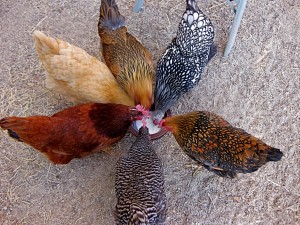If you’re ready to start your flock the first thing to do is decide what kind of chickens you want.
• Meat birds
• Egg layers
• Dual purpose (good for meat and eggs)
• Weather tolerant in your climate
• Fancy breeds (colorful and or unusual)
• Egg colors
• Temperament
• Broodiness
• Self-reliant (good foragers)
If you’re raising birds for meat, the Cornish Rock types develop amazingly fast and are ready to butcher by 6-8 weeks. They’ve been bred to eat constantly and develop large meaty muscles in a short amount of time. If you let them grow much more than 3 months, they will not be able to walk, and will die of heart attacks.
Most people want dual purpose breeds, which are good egg producers but are larger bodied. Rhode Island Reds, Barred Rocks, Orphingtons, Brahmas, Delawares, Austrolorps are a few examples. Want really good layers? Leghorns, Wyandottes, Plymouth Rocks and other breeds can produce up to one egg a day. A more average rate is on egg every two or three days. Laying usually slows down during molting and winter months. You can force your hens to lay in winter if you put a timed light in the coop.
Some birds tolerate heat and humidity better than others. If you live in a cold climate make sure your birds are cold hardy. Small wattles and combs are less susceptible to frostbite. Large bodied birds withstand cold better than small or slight birds. Bantams (the minis of the chicken world) need special treatment in the winter. They look cool but more often than not you’re sacrificing looks for performance. Most fancy, colorful breeds are not good layers, not cold hardy and are slower to mature.
If you want particular egg color and size, you can select for that too. For example, Amaraucanas lay eggs that usually range from blue to green to olive. Marans lay darker shades of brown. Some breeds lay white eggs and others different shades of tan. Family friendly, easy to handle birds include Orphingtons, Australorp, Rhode Island Reds, and Delewares. Some breeds are better at foraging than others. Some are better at sitting on the nest once they have a clutch off eggs (this is called being ‘broody’) and raising their babies when they hatch.
You can find more specifics about breeds at these websites, or look for breeds on hatchery websites.
http://www.eggzy.net/breeds
http://www.sagehenfarmlodi.com/chooks/chooks.html
http://www.wilkamdai.com/poultry_chicken_breeds_of_Interest.html
When you choose what you want, make sure you have a few backups that fit your criteria. Some breeds are just really hard to find, and some have off years that they don’t produce as well at the hatcheries. I’d suggest mixing it up at first and trying a few different types to discover your favorites.
You can order fertilized eggs and incubate your own, order day old chicks, order partially grown birds, or adult birds from a local breeder. Most people order chicks, so I’ll address this. When you’re ready to order them from a hatchery or pick them up from the feed store, you’ll probably want most if not all females (pullets). A small local breeder won’t be able to tell you if a chick is male or female until it starts to get its adult plumage, around 6-8 weeks. Sexing chicks is really hard to do, and even the hatcheries don’t always get it right. Even if they are advertised as ‘pullets’, there is still a chance the chick is a male. You’ll need to decide ahead of time what to do with it if you end up with a rooster if you don’t want to keep it.
You can order your chicks in the mail from a hatchery. Usually there is an order minimum. The chicks will be mailed to you and this minimum order size ensures that they produce enough body heat to keep each other warm. The ordering season is late February through early June, when temperatures are more ideal. If you buy them at a local feed store, look for chicks that are not scrawny or lethargic, with no discharge in eyes or nostrils. If there is a lot of fecal matter stuck to their vent it can block up and they can die from it, so avoid this. If you only want females, don’t pick the biggest chicks from the bunch. The males tend to be slightly larger than the females. Regardless of where you get your chicks or hens, always pick the healthiest, most active ones from the bunch.
Check back for the next article about chickens, Setting Up Your Brooder For Chicks







